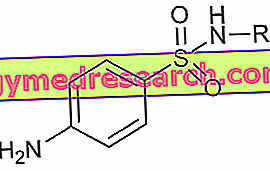Generality
Sulfonamides (also known as sulfonamides) are chemotherapeutic antibacterial drugs obtained by chemical synthesis, unlike antibiotics that have natural origins.

Sulfonamides - General Chemical Structure
From the chemical point of view, these antimicrobials are sulfonamides that derive from azo dyes.
Sulfonamides were among the first antibacterials to be marketed and used in therapy.
Nowadays, however, the use of sulfonamides has decreased in favor of antibiotics such as, for example, penicillins or cephalosporins. However, their relatively low cost means that these antimicrobials still find a place in the market for anti-infective agents.
The discovery of sulfonamides
The discovery of the antimicrobial activity of sulfonamides happened by chance in the mid-1930s.
It all started when the German chemist Gerhard Domagk began to study the activity of a particular azo dye, the " red Prontosil ".
Domagk hoped that this dye could be retained by some types of bacterial cells and not by human cells (similar to what happened with the Gram stain method), in an attempt to obtain a potential poison against the bacteria that were able to to retain that same dye. However, the red Prontosil turned out to be absolutely ineffective in in vitro tests. Instead, it was shown to be effective in vivo in the treatment of streptococcal infections in mice.
A few years later, in France, chemists and pharmacologists Jacques Tréfouël, Daniel Bovet and Federico Nitti undertook studies on the red Prontosil.
The chemists discovered that the urine of the dyes treated with the dye was effective in inhibiting bacterial growth in vitro, which was not the case when using red Prontosil as such.
The fractionation of the urine of mice treated with red Prontosil led to the identification and isolation of the compound with antibacterial activity: the amide of para-aminobenzensulphonic acid (or p-aminobenzensulphonic acid), better known as sulfanilamide .
The researchers came to understand that the red Prontosil itself was not endowed with antibacterial activity, but - once taken by the mouse - it suffered a metabolic degradation in its liver that led to the synthesis of the antibacterial molecule proper, that is to the synthesis of sulfanilamide . Therefore, today, the red Prontosil would be considered a prodrug.

Indications
For what it uses
Sulfonamides are antibacterials with a broad spectrum of action, and are particularly effective against Gram-negative bacteria (with the exception of Pseudomonas spp.).
There are numerous types of sulfonamides, each of which is suitable for treating certain types of infections.
In general, it can be stated that sulfa drugs can be used in the treatment of:
- Infections caused by Escherichia coli, Klebsiella spp., Proteus spp., Streptococcus pyogenes, Streptococcus pneumoniae and Haemophilus spp. ;
- Primary uncomplicated infections of the urinary tract;
- Eye infections;
- Colitis;
- Crohn's disease.
Furthermore, a sulfonamide in particular (sulfadiazine) is used topically for the treatment of burns and is also effective against certain types of fungi.
Action mechanism
At the concentrations used in therapy, sulfa drugs have a bacteriostatic action, ie they inhibit bacterial cell growth.
Sulfonamides can be defined as antimetabolites, ie molecules that interfere with the formation and / or use of a normal metabolite present within the bacterial cell.
More specifically, these antibacterials interfere with the synthesis of tetrahydrofolic acid, an essential intermediate for the synthesis of purine and pyrimidine bases that will then go on to constitute bacterial DNA.
In detail, the sulfa drugs in a competitive manner inhibit one of the enzymes involved in the synthesis of the aforementioned tetrahydrofolic acid: the dihydropteroate synthetase . The sulfonamides replace the endogenous substrate of this enzyme, para-aminobenzoic acid (or p-aminobenzoic acid or PABA ).

However, a simple increase in the cellular concentration of PABA is sufficient to displace the sulfonamide from the bond with dihydropteroate synthetase and thus resume the synthesis of tetrahydrofolic acid.
To overcome this phenomenon, very often, sulfa drugs are administered in combination with trimethoprim (or trimethoprime), an antibacterial drug that inhibits dihydrofolate reductase, another of the enzymes involved in the synthesis of tetrahydrofolic acid.
With the combination of these two antibacterial drugs, therefore, there is a double enzyme inhibition which therefore has a bactericidal effect.
It is important to point out that sulfa drugs are very selective antibacterials for bacterial cells, since dihydropteroate synthetase is not present in human cells.
Resistance to sulfonamides
Sulfonamide resistance is quite widespread but is achieved slowly.
Bacteria can develop resistance to these antibacterials substantially through three different mechanisms:
- Production of enzymes resistant to sulfonamides;
- Increased production of PABA, in such a way as to displace the bond of sulfonamide with dihydropteroate synthetase;
- Give up this synthetic route and use alternative metabolic pathways for nucleic acid synthesis.
Classification of sulfonamides
Sulfonamides can be classified according to their chemical structure. We can therefore make the following subdivision:
- Sulfasalazopyridine (or sulfasalazine) and sulfapiridine belong to this group.
- Derivatives of 2-amino pyrimidine, sulfadiazine, sulfametazine and sulfamethoxydiazine belong to this group;
- Derived from pyridazine, sulfacloropiridazine and sulfamethoxypyridazine belong to this group;
- Derived from pyrazine, sulfalene belongs to this group;
- Derived from pentatomic heterocycle, sulfamethoxazole is part of this group.
Side effects
Obviously, each sulfonamide can trigger different types of side effects, but some of these adverse effects may be common to the entire class of antibacterials.
Among the various undesirable effects typical of the class of sulfonamides, we recall:
- Allergic reactions in sensitive subjects that may occur in the form of fever, rash and photosensitization;
- Kidney and liver damage;
- Hemolytic anemia and other blood disorders;
- Stevens-Johnson syndrome;
- Ulceration of the mucous membranes of the eyes, mouth and urethra.



